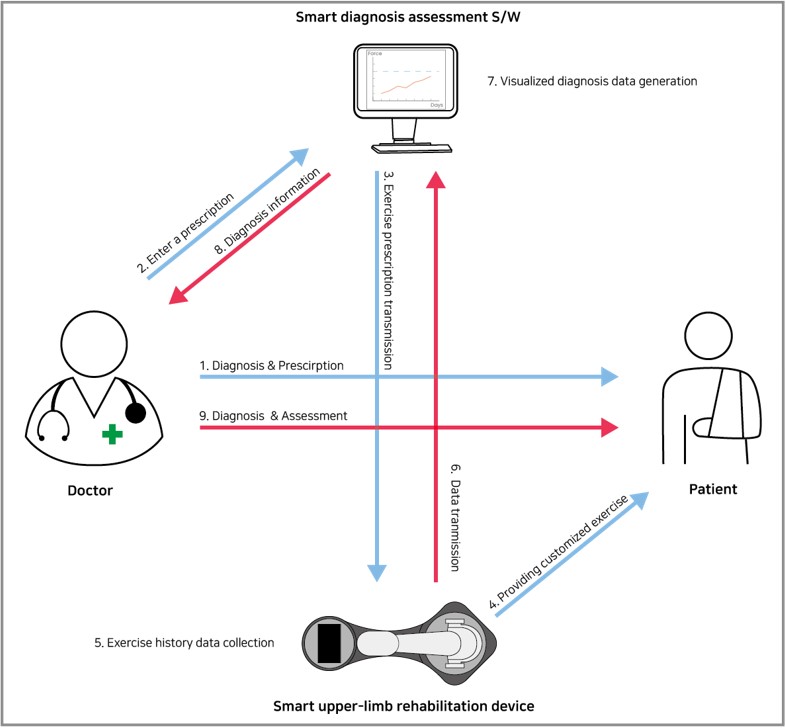
Master's Thesis
The integrated design process of a rehabilitation exercise system: Elbow joint rehabilitation device and service
재활 운동 시스템 디자인: 주관절 재활 기구와 서비스
This study employed a design agenda based on an integrated design process for a new rehabilitation exercise device and service system as a potential solution for treating upper-limb rehabilitation confronting the Korean rehabilitation treatment industry.
본 연구는 국내 재활치료 산업이 직면한 문제점을 해결하기 위한 잠재적 해결책으로서 통합설계 과정을 통해 디자인된 새로운 재활 운동 기구와 서비스 시스템을 제안하는 것이다.
Process
For generating the design agenda, adopting a mixed design process consisting of both the main design process treating the overall process and the sub design process treating the phase process. Activities were conducted to define the design requirements while carrying out the design process. These activities included interviews with rehabilitation medical specialists at Kyungpook National University Hospital and Ulsan National University Hospital, visits to the occupational rehabilitation therapy room, and reviewing prior research surveys.
프로세스
디자인안을 개발하기 위하여 주 디자인 프로세스와 서브 디자인 프로세스 과정으로 이루어진 혼합 디자인 프로세스를 채택하여 진행하였다. 디자인 프로세스 중 디자인 요구사항 정의를 위한 활동을 수행하였다. 이는 경북대학교병원 및 울산대학교병원 재활의학과 전문의의 인터뷰, 작업재활치료실 방문, 선행 디자인 연구 등이 포함된다. 이 활동에서 수집한 정보 중 키워드를 추출하고 분석함으로써 국내 상지재활기기의 디자인 요구사항과 동향을 파악하였다. 경북대학교병원 및 울산대학교병원 재활의학과 전문의, 전자 부품 정밀제어 업체 ㈜오토모션, 울산과학기술원 디자인학과 교수 등을 통하여 디자인 결정 및 요소 결정에 필요한 전문지식과 배경을 획득할 수 있었다. 디자인 결과물은 인터뷰 결과물, 서비스 시스템의 디자인 그리고 서비스 시스템 내의 단말기 디자인으로 나누어 진다.


Prototyping
This activity made it possible to understand the design requirements and trends in the design of upper-limb rehabilitation devices in Korea by extracting keywords and analyzing the collected information. A specialist in rehabilitation medicine at Kyungpook National University Hospital/Ulsan University, a company specializing in precision control, and a professor of design at Ulsan Institute of Science and Technology provided assistance and professional knowledge required in determining design the elements during the design process.
프로토타이핑
인터뷰 결과는 국내 재활병원에 재활로봇이 쉽게 도입되어 활용되지 못하는 이유에 대하여 의료 환경, 기존 제품, 운동, 병원 시스템으로 4가지의 주요 정보로 분류하여 정리되었다. 상지재활치료 서비스 시스템은 컨셉 디자인 단계까지 완료되었다. 상지재활치료 서비스 시스템의 단말장치는 전반적으로 System-level design까지 진행되었으며, 부분적으로 Detail-level design까지 수행되었다.

Outcome
The final result is divided into the interview result, the service system’s design and the device’s design within the service system. Several reasons were identified from interview results as to why a rehabilitation robot is not easily introduced and used in the Korean rehabilitation hospital based on four categories: medical environment, existing products, exercise, and hospital systems. The service system completed the concept design level. The device design was completed at the system-level design and partially the detail design. The device design’s specific results include establishing the type of product, drawings, IF design contest entries, and patent applications.
결과물
서비스 시스템의 단말장치 디자인의 구체적 결과물은 프로토타이핑, 도면, IF 디자인 어워드 출품 자료, 특허 출원이 포함된다. 본 연구로 얻은 디자인안의 기대 효과는 스마트 재활 방법의 도입, 의료 복지 증진, 진단 및 처방의 정량화를 통한 의료인의 업무 부담 감소, 그리고 환자 맞춤형 운동 제공 등이 있다.
또한, 디자인 결과물을 통해 재활의료 전문가와 전자 제품 정밀제어 업체는 후속 연구를 진행할 수 있는 기틀을 제공하였다. 본 연구를 통하여 국내 상지재활운동 기기 영역에서 디자인이 리더십을 보여 엔지니어 및 타 전문가들을 제품 개념 설계 이후의 단계를 수행할 수 있도록 하는 한 가지 예시를 제시하였다.


